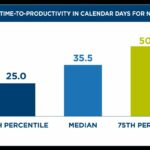In a whirlwind of change and uncertainty, the journey of transitioning employees can be arduous and disorienting. However, there exists a guiding light amidst this labyrinth: outplacement services. Human Resources, as the guardians of organizational well-being, hold the key to facilitating smooth employee transitions through the maze of career transformation. This article aims to shed light on the undeniable value that HR brings to the table in supporting and empowering individuals during this period of profound change. By examining the multifaceted facets of outplacement, we will uncover how HR professionals can serve as compassionate navigators, skillful confidants, and unwavering champions, ultimately leading employees toward brighter horizons.
1. Transforming Challenges into Opportunities: How HR Professionals Can Support Employees in Smooth Transitions
As HR professionals, it is our responsibility to guide employees through transitions, ensuring a smooth and positive experience during times of change. Challenges that arise during these transitions can present unique opportunities for growth and development. By leveraging our expertise and providing the necessary support, we can empower employees to embrace change, navigate challenges, and ultimately thrive in their new roles.
Here are a few ways HR professionals can support employees:
- Clear communication: Maintaining open and transparent communication channels is crucial. Clearly communicate the reasoning behind the transition, the expected changes, and the support available. Encourage feedback and provide opportunities for employees to voice their concerns or ask questions.
- Individualized support: Recognize that each employee may have unique needs during a transition. Offer personalized support, such as one-on-one meetings or personalized training plans, to address specific challenges and ensure a successful transition.
- Training and development: Provide appropriate training and development opportunities to equip employees with the skills needed for their new roles. This can involve conducting relevant workshops, arranging mentoring programs, or offering access to online resources.
- Recognize and celebrate milestones: Acknowledge and celebrate milestones achieved during the transition process. This reinforces positive progress and motivates employees to continue embracing change. Recognizing their efforts fosters a sense of accomplishment and enhances their confidence in their abilities.
By actively supporting employees during transitions, HR professionals can create a positive and supportive environment, paving the way for successful adaptation and growth in the organization.
2. Guiding Employees Towards New Horizons: The Role of HR in Outplacement to Ease Transitions
When it comes to navigating the uncertain waters of career transitions, employees often find themselves in need of guidance and support. This is where the role of HR in outplacement becomes crucial. By offering a structured approach to easing transitions, HR professionals can help employees explore new horizons and find their footing in unfamiliar territories.
One of the key ways HR supports employees during outplacement is by providing access to resources and opportunities for upskilling and reskilling. This can involve connecting employees with relevant training programs, workshops, or online courses to enhance their skills and expertise. By facilitating continuous learning, HR helps employees adapt to changing job markets and increases their employability.
- Mentoring and coaching: HR professionals can pair employees with mentors or career coaches who have experience in the employees’ desired industry or role. This guidance can provide valuable insights and advice, helping employees make informed decisions and navigate the challenges they may face.
- Networking support: HR can organize networking events or provide access to virtual platforms that allow employees to connect with professionals in their desired fields. Networking can open doors to new opportunities, uncover unadvertised job vacancies, and provide valuable industry contacts.
- Resume and interview preparation: HR professionals can assist employees in updating their resumes and honing their interview skills. This support ensures employees are effectively communicating their qualifications and experiences, increasing their chances of securing new opportunities.
3. Nurturing Growth Amidst Change: Unlocking HR Strategies for Seamlessly Transitioning Employees
In today’s rapidly evolving business landscape, organizations across industries are constantly faced with the need to adapt and change. Whether it’s due to mergers and acquisitions, technological advancements, or shifts in market demands, the success of any transition largely depends on the ability of HR strategies to support and nurture employee growth.
Unlocking HR strategies for seamlessly transitioning employees involves a combination of fostering a culture of resilience, providing targeted training and development opportunities, and implementing effective communication channels. By embracing change as an opportunity for growth, organizations can empower their workforce to not only navigate transitions but also thrive in the face of uncertainty.
- Cultivate a culture of resilience: Building a resilient workforce starts with emphasizing the importance of adaptability and innovation. Encouraging employees to embrace change as an opportunity for personal and professional growth can help create a positive mindset, instilling confidence in their ability to navigate transitions effectively.
- Provide targeted training and development: Equipping employees with the necessary skills and knowledge to thrive in a changing environment is crucial. By identifying specific training needs and designing customized programs, HR can ensure that employees have the resources they need to succeed during transitions.
Nurturing growth amidst change requires open and transparent communication channels. It’s essential for HR to foster an environment where employees feel comfortable asking questions, expressing concerns, and receiving timely feedback. This can be achieved through regular town hall meetings, one-on-one check-ins, and virtual platforms that enable continuous dialogue.
- Create opportunities for collaboration: Encouraging cross-functional collaboration and teamwork can help employees feel more supported during transitions. By fostering a sense of community, employees can tap into each other’s expertise, share best practices, and collectively contribute to the organization’s success.
- Recognize and reward resilience: Acknowledging and appreciating employees’ resilience and ability to adapt during transitions can boost morale and motivation. Implementing recognition programs, such as “Employee of the Month” or team-based incentives, can demonstrate the organization’s commitment to valuing and supporting its employees.
In conclusion, HR strategies play a crucial role in nurturing growth amidst change. By cultivating a culture of resilience, providing targeted training and development, implementing effective communication channels, creating opportunities for collaboration, and recognizing employee resilience, organizations can unlock the full potential of their workforce during times of transition.
4. Smooth Sailing Ahead: How HR Can Navigate Employee Transitions through Effective Outplacement
When it comes to managing employee transitions, effective outplacement is crucial in ensuring a smooth journey ahead. HR professionals play a key role in guiding employees through these challenging times, helping them navigate the process with compassion and professionalism. By implementing a well-structured outplacement program, the transition becomes an opportunity for growth, both for the departing employee and the organization as a whole.
Here are some key strategies that HR can employ to navigate employee transitions:
- Offer personalized career coaching: Each employee’s situation is unique, and providing personalized career coaching can help them explore new opportunities and develop a plan for their future endeavors. By addressing their concerns, identifying transferable skills, and assisting with resume writing and interview preparation, HR professionals can empower employees to confidently embrace their next career move.
- Provide emotional support: Transitioning out of a job can be emotionally challenging for employees. HR can create a supportive environment by organizing one-on-one counseling or group workshops to address their emotional needs. Offering resources for managing stress, building resilience, and enhancing emotional well-being can help employees cope effectively during this transitional period.
- Facilitate networking opportunities: Building a strong professional network is crucial for employees seeking new job opportunities. HR can organize networking events, online webinars, or provide access to relevant professional associations to foster connections and increase their chances of finding suitable employment.
In conclusion, the winds of change blow swiftly, and it is with utmost importance that organizations adapt and embrace the transformative journey of employee transitions. Through the artistry of outplacement, HR professionals have the power to nurture resilience, foster growth, and pave the way for a smoother expedition into new horizons.
As the orchestrators of this delicate dance, HR practitioners hold the key to unlocking the potential within each individual as they embark on a fresh chapter in their professional lives. While a tide of uncertainty may wash over both employees and organizations alike, the waves of outplacement can guide them towards a shoreline of opportunity, renewal, and prosperity.
With empathy as their compass, HR seamlessly connects the dots between departing employees and their next steps, crafting customized roadmaps that will lead them towards success. In this ethereal waltz, HR walks alongside employees, providing unwavering support as they gracefully navigate the labyrinth of career transitions.
Through a symphony of resources, training, and counseling, the harmony of outplacement resonates, ensuring that no departure goes unnoticed nor unguided. From resume crafting to interview preparation, from networking avenues to skill development programs, HR illuminates the path with resources designed to ignite resilience within individuals, empowering them to rise higher than before.
And it is through this delicate amalgamation of guidance and reassurance that HR not only preserves the goodwill of the departing employees, but also fortifies the foundation of the organization itself. By investing in the welfare of their workforce, companies redefine their values, shaping themselves into beacons of support, professionalism, and humanity.
In this grand ballet of transitions, HR professionals become guardians of the legacy of every employee, mindful of the invaluable contributions they have made. They weave an invisible but unbreakable thread of connection, reminding employees that their journey may have taken a different path, but their potential remains limitless.
So, let us embrace this artistic tapestry of outplacement, where HR professionals skillfully facilitate smooth employee transitions. Let us recognize the significance of the role they play in nurturing new beginnings and shaping brighter futures. Together, we can create a harmonious cadence of support and growth, ensuring that no departure is merely an end, but rather an intricate stepping stone towards greater achievements for both individuals and organizations alike.








